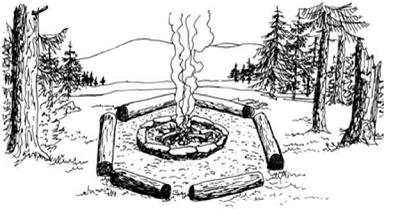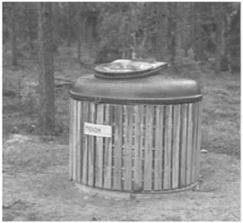On picnic sites and around fireplaces litter of various kinds is generated all the time. If food sales, such as ice cream on hot days, also take place, then the volume of litter is multiplied many times. There is nothing so unsightly as a site where litter is left lying around.
Thus litter management is crucial, and there are two approaches. One is to encourage people to take their litter away with them, and not to supply bins anywhere on the site. This is usually successful in the remoter sites, but is less so in the busy ones where litter left by the small percentage of people who are careless or less responsible will still need to be picked up. Signs suggesting that people should take their litter home should then be posted around the site in key locations to and from the car park.
The second approach is to accept that people will want to leave litter and to provide bins for it. These have to be of sufficient numbers and be located in suitable places, such as next to the exits from the car park to the picnic area and toilets, at the toilets and in key locations in the picnic area. Places to avoid are next to tables (attracts wasps, nasty smells, hygiene risks), attractive views or hidden corners where people have to go out of their way to deposit litter.
Bins have to be convenient for anyone to put litter in and for workers to empty out, and must be secure from vermin, ranging from bears, ponies and sheep to chipmunks, squirrels and seagulls. Depending on the circumstances the bins might require heavy lids of fireproof materials that are chained to frames or posts. While wire baskets made to fit custom designs might be attractive, it is best to use polythene or paper rubbish (trash) sacks placed inside wooden, metal or plastic containers. Many designs for bins exist, most of which suit urban areas but are of inappropriate materials for the outdoors, such as plastic-covered metal, brightly coloured plastic or combinations of them.
 |
The campfire circle: a large fire area surrounded at a safe distance by log seats. Ideal for summer evening singsongs!
 |
Some litter bin designs: (a) A single wooden slat design to hold a wire basket or polythene sack. Unfortunately, the lack of a lid can mean that litter blows away or is attractive to birds and animals.
(b) A well-designed bin. The frame and lid are made from galvanized steel clad in timber slats. Litter is collected in a paper sack. The bin is fixed to a firm base such as a concrete slab. Aarhus
City Forest, Denmark. (c) An unusual bin made of concrete and fibreglass and painted to fit into the character of its surroundings—ancient cave dwellings at Walnut Canyon National Monument, Arizona, USA. (d) A bear-proof steel bin with special lid, unable to be opened by bears, and weighted with a concrete slab so as to make it impossible to push over. The hard metal character is relieved by the wooden slat cladding, but it should be possible to cover or bury the concrete base. (e) Another bear-proof bin swinging by chains from a stout frame. Made of an oil drum with a special top, this is ungainly and not very attractive.
|
|
This is a good design for a large-capacity bin.
The wooden slats help it to fit into the forest landscape. The lid, made from black plastic, is unobtrusive. It would probably not be bear-proof.
Akasamylly, Finnish Lapland.
Bins should be fixed to a solid base or dug into the ground to prevent them from being knocked over by people or animals. Lids are often needed to prevent the litter from blowing away or animals entering, but sometimes they can be too heavy for small children to use. Smaller, self-closing flaps in larger lids can be used instead. The size of bins should reflect the level of use of the site and the frequency of emptying. Overflowing bins surrounded by rubbish are worse than having no bins at all, and reflect badly on the management of the site.
The best materials for litter containers in the outdoors are slatted timber, half round or sawn and left to weather, or stained to fit into the surroundings, and sometimes zinc-coated steel. Plastic lids of earth tones with animal-proof devices can be acceptable. The enclosing structure can be emptied by opening the top or a side panel to release the internal sack, which can then be tied up and carried to a truck for disposal. Stone-built devices sometimes fit, but they are not movable, and they have to be emptied by lifting sacks out of the top. Metal frames with lids to hang black plastic sacks have also been used, but they look unsightly, and the bags risk being damaged by people or animals, allowing the rubbish to escape.
In environmentally aware places such as Scandinavia, recycling of rubbish is practised in the outdoors. Several bins might be located by the car park and people encouraged to separate glass, aluminium cans and other litter to be sent for recycling. While involving more work for the operator, this vastly reduces the overall requirement to dump rubbish elsewhere and, as good sustainability practice, it should be considered in every circumstance.
Some site operators may be tempted to install big skips or dumpsters on the site so that low-cost collection can take place. These are ugly and out of place, they often attract unauthorized tippers, and are examples of cost factors outweighing the needs of the visitor and the environment.




